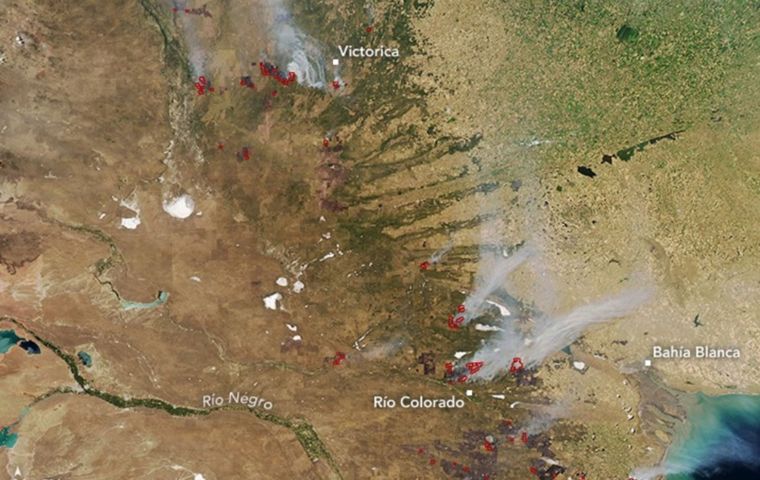MercoPress. South Atlantic News Agency
NASA satellite keeps track of wildfires in Argentina
 NASA’s Aqua satellite captured an image of a wildfire in La Pampa Province, on January 29, 2018.
NASA’s Aqua satellite captured an image of a wildfire in La Pampa Province, on January 29, 2018. Roughly 12,000 wildfires burn each year in Argentina, charring more than 1.3 million hectares (5,000 square miles) of forest and grasslands. The Moderate Resolution Imaging Spectroradiometer (MODIS) on NASA’s Aqua satellite captured an image of one of them on January 29, 2018.
The fire was burning in La Pampa Province, in an area where cattle graze among the espinal, a dry forest of thorny shrubs and small trees. The cause of the fire was not clear, but ranchers routinely light fires in this region to improve the quality of forage.
The image shows a prominent pyrocumulonimbus,—a tall, cauliflower-shaped cloud that appears as an opaque white patch over darker smoke in satellite imagery. Pyrocumulonimbus clouds—also called cumulonimbus flammagenitus —are similar to cumulus clouds, but the heat that forces the air to rise (which leads to cooling and condensation of water vapor) comes from a fire instead of the sun-warmed ground. In order to classify a cloud as pyrocumulonimbus, cloud top temperatures observed by satellites must be -40°C (-40°F) or cooler.
Several factors affect the color of smoke in a satellite image, including the temperature of the fire, the composition of the fuel, and the amount of moisture in the smoke. In this case, an optical effect is likely causing the pyrocumulonimbus to appear brighter than the older smoke below.
“Fresher particles are smaller and scatter light differently than larger, fatter, and older smoke particles,” explained Santiago Gassó, an atmospheric scientist at NASA’s Goddard Space Flight Center. As a result, older smoke tends to look brown and more like dust.
Pyrocumulonimbus clouds can produce full-fledged thunderstorms with lightning and heavy rain—sometimes so much rain that they help extinguish the fires that created them. In this case, however, the fire appeared to keep burning vigorously, as revealed by images collected the next day.




Top Comments
Disclaimer & comment rulesCommenting for this story is now closed.
If you have a Facebook account, become a fan and comment on our Facebook Page!